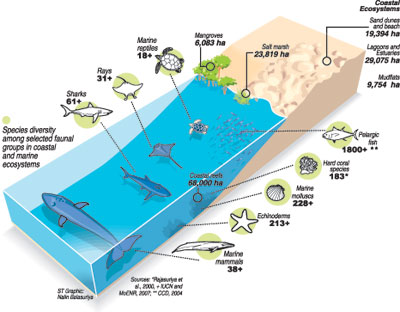Over-fishing is reducing fish populations to dangerously low levels in the Indian Ocean and seas around the world, warned fisheries experts.
Dr. Rekha Maldeniya of the National Aquatic Resources Research and Development Agency (NARA) delivered the keynote speech at a seminar on Marine Biodiversity, on May 22, which was designated the International Day on Biological Diversity.
Most of the common commercial fish stocks, including fish like the hurulla (herring), are depleted by over-exploitation, said Dr. Maldeniya, adding that sea cucumber, chank, lobster and shrimp are high on the list of threatened species. The expert quoted findings in the Fisheries Resources Survey, conducted over a four-year period (2006-2010). Coastal fish are the most in danger, but many offshore fish stocks, including tuna and shark, are over-fished, the expert said.
Over-fishing led to the demise of the pearl oyster stocks, in Mannar, Dr. Maldeniya reminded the audience. Sri Lanka was once famous for its pearls, but that industry has died out completely, and the same fate awaits other fish species unless precaution is taken, she said.
Management decisions are being delayed by a lack of sufficient data for a good understanding of the country’s coastal and marine ecosystems. “There is a lot of ongoing research on land-based ecosystems, but not enough research on marine ecosystems. Marine biodiversity research is expensive, and we do not have enough trained people to do the research. Even the little research output we have, such as the Environmental Impact Assessments, is under-utilised. While our main concern is commercially valuable fish species, other marine creatures are also under great pressure.”
Weak enforcement of laws and regulations has also contributed to the decline in coastal fish stocks. Dynamiting and the continued use of banned types of fishing nets must end if fish stocks are to be maintained. Some countries use large nets such as the purse seine to catch tons of fish. Such action depletes stocks very quickly.
Taking management action, the expert said, is not easy, as many fish stocks overlap ocean areas belonging to different countries. Some pelagic fish, like tuna, are migratory, so protection by one country alone does not ensure a species’ survival.
All marine habitats are interconnected. For example, certain marine fish come to estuaries to breed, and if the estuaries are not protected, the species is threatened. Habitat loss, degradation and fragmentation, destructive fishing methods, pollution, the spread of invasive alien species – all are serious threats to marine life.
Sri Lanka exports 20,000 metric tons of fish a year. A total of 650,000 people are employed in the fisheries industry, including 150,000 fishermen, 100,000 in fishing-related services, and 400,000 in the fish trade. Up to 2.4 million persons are sustained by fish consumption. Fish species contribute to 70 per cent of the country’s animal protein consumption.
How much life is there in the sea?
The marine biodiversity found around Sri Lanka ranges from microscopic algae to the giant Blue whale.
During a 10-year period, from 2000 to 2010, scientists around the world collaborated in an unprecedented effort to determine how much life there is in the sea. The Census of Marine Life, carried out under the Convention of Biodiversity, involved 2,700 scientists from more than 80 countries. They studied surface seawater and probed the deepest, darkest depths of the ocean, sailed tropical seas and explored ice-strewn oceans in the Arctic and the Antarctic.
By the time the census was concluded, a total of 1,200 new species had been added to the known roster of life in the sea. Scientists are still working their way through another 5,000 specimens to determine whether they are new discoveries. The number of known marine species is estimated at around 250,000. In its final report, the census team suggested the number could be at least a million, while others believe the figure could be double that. |


